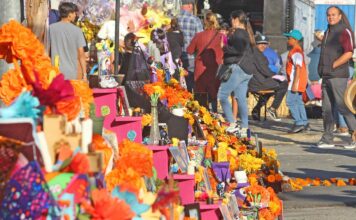We who love wine are very lucky to be living in these times,
when there is a huge selection of wines available to us. The local
grocery store stocks every conceivable varietal from virtually all
of the world’s premium wine-growing regions, and at reasonable
prices. But it wasn’t always so.
We who love wine are very lucky to be living in these times, when there is a huge selection of wines available to us. The local grocery store stocks every conceivable varietal from virtually all of the world’s premium wine-growing regions, and at reasonable prices. But it wasn’t always so.
I grew up in the Midwest. Battle Creek, Mich., to be exact. Home of Kellogg’s and Post Cereals, famed abolitionist Sojourner Truth and comedian Dick Martin of “Laugh-In” fame.
When I turned 18, the legislature of my home state, in some unusually weird fit of stupidity, decided that since kids were dying in Vietnam, it was perfectly logical that they should be able to legally purchase alcohol. Oh, yeah, and they could also vote. It occurred to me at the time that this move was a clever ploy on those politicians’ part.
Get all the kids between 18 and 21 loaded and maybe they would vote the incumbents back in out of sheer drunken gratitude.
Needless to say, that little experiment didn’t last long – it was rescinded three years later, in fact, just when I turned 21 – but the voting age is still 18.
Anyway, my friends and I, being the sophisticated Battle Creekians that we were, became enamored of Boone’s Hill Apple Wine.
Boone’s Farm was the popular drink of the day. This was the early 1970s, and no one in Michigan had yet heard of Napa.
Boone’s Farm was from California, not that any of us cared enough to read the label. It came in two flavors then, Apple and Strawberry Hill. They still make the stuff, and it can be found in the grocery store on the bottom shelf.
It comes in all sorts of odd Day-Glo colors now, and I suppose that it still appeals to younger folks.
There were other wines in this category around. Bali Hai, Ripple and MD 20/20. MD was known as “Mad Dog” because its alcohol content was supposedly 20 percent.
Actually, MD stood for Mogen David, an East Coast maker that specializes mostly in Kosher, Concord grape wines. I don’t have first-hand knowledge, but I have it on reliable authority that you don’t want to wake up with a hangover from that stuff.
As my taste evolved and I sought more sophisticated wines, there wasn’t a whole lot to choose from.
The shelves of my local Kroger’s and IGA hadn’t yet been stocked with wines from Australia, Chile, Paso Robles or Monterey, and I doubt if anyone in that part of the country had even heard of San Benito County. Come to think of it, they probably still haven’t.
Some were available, though. And some of them still are. Blue Nun from Germany is a Liebfraumilch. The word translates to English as “milk of Our Lady,” and on the label is depicted the image of a serene nun dressed in a blue habit.
I always thought that was more than a little weird. Liebfraumilch is a pleasant enough wine, and it has been around for a long time. Blue Nun is just the most well-known in the United States. It’s pleasant, but being made from the Riesling grape, can be a tad sweet.
Other holdouts include Lancer’s, that Portuguese import in the glass bottle that’s painted to look like terra cotta. Lancer’s is slightly fizzy, and comes in white and rosé versions. If I recall correctly, Lancer’s sidestepped the whole cork/screwtop debate by using a bottlecap closure. Maybe they changed that.
One of my favorite wine names is Cold Duck. My parents really liked that stuff, and always had a bottle in the fridge for special occasions like New Year’s Eve, anniversaries, birthdays and those precious, rare moments when I brought home a good report card.
Cold Duck has an interesting history. In theory, the pink sparkling wine is supposed to be made of Champagne, sparkling burgundy and sugar.
The reality is that Cold Duck is just cheap fizzy pink wine. It started out as a way for Bavarians to avoid wasting left-over champagne (what’s “left-over champagne?”) by mixing it with the aforementioned cold sparkling burgundy.
It was called “kalt ende” or “cold end,” because it was made from the ends of bottles of wine. Over the years, “ende” became “ente,” German for “duck.”
Your guess as to how that happened is as good as mine. At any rate, Cold Duck is still around. According to one of my sources, it was at one time the most popular sparkling wine in the United States.
There are others, of course: Lambrusco, Sangria, Riunite (on ice – how nice!) to name a few.
There is clearly a market for these beverages, just as there is a market for wine coolers and Mike’s Hard Lemonade.
But in some cases, it really is a stretch to call this stuff wine.
While they meet the strictly technical definition of wine by being produced by the fermentation of fruit juices, somehow I can’t imagine any of them making the cover of Wine Spectator any time soon.












